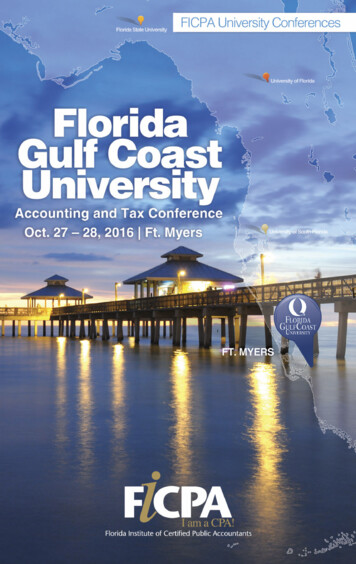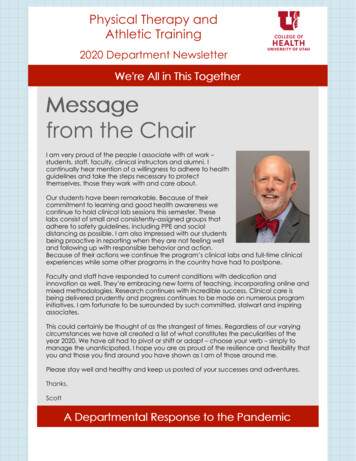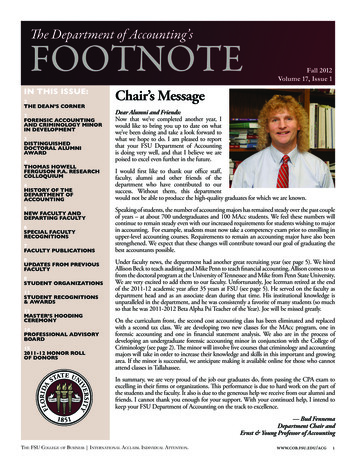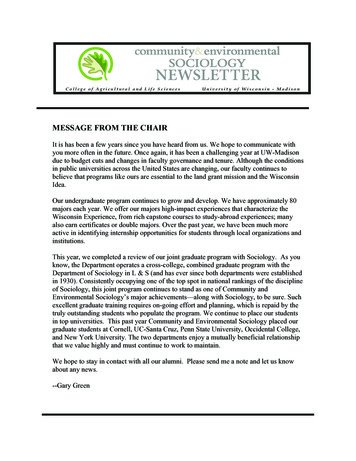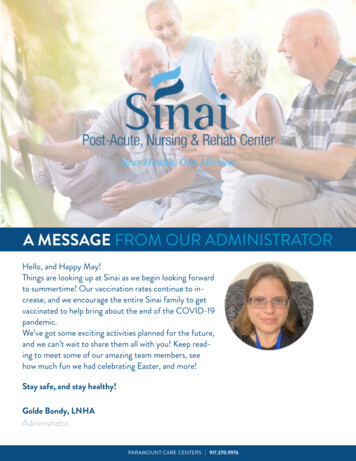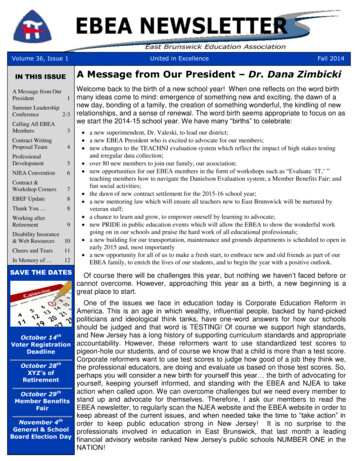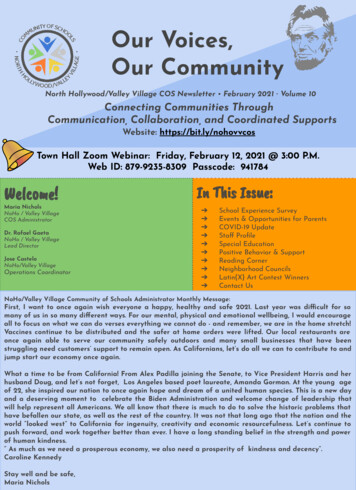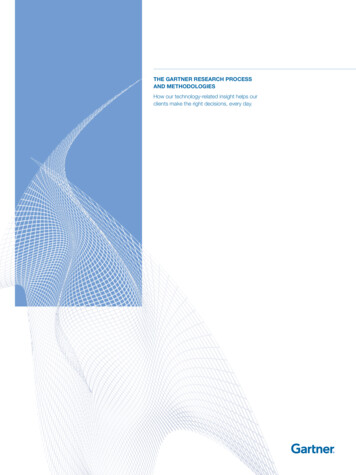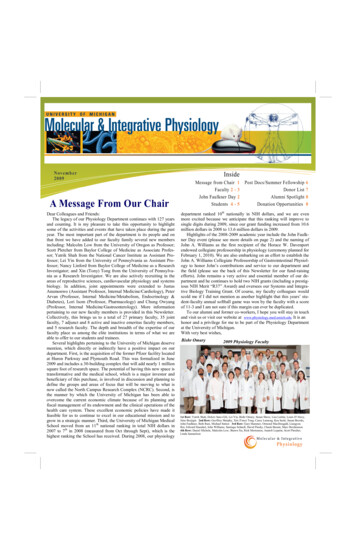
Transcription
November2009A Message From Our ChairDear Colleagues and Friends:The legacy of our Physiology Department continues with 127 yearsand counting. It is my pleasure to take this opportunity to highlightsome of the activities and events that have taken place during the pastyear. The most important part of the department is its people and onthat front we have added to our faculty family several new membersincluding: Malcolm Low from the University of Oregon as Professor;Scott Pletcher from Baylor College of Medicine as Associate Professor; Yatrik Shah from the National Cancer Institute as Assistant Professor; Lei Yin from the University of Pennsylvania as Assistant Professor; Nancy Linford from Baylor College of Medicine as a ResearchInvestigator; and Xin (Tony) Tong from the University of Pennsylvania as a Research Investigator. We are also actively recruiting in theareas of reproductive sciences, cardiovascular physiology and systemsbiology. In addition, joint appointments were extended to JustusAnumonwo (Assistant Professor, Internal Medicine/Cardiology), PeterArvan (Professor, Internal Medicine/Metabolism, Endocrinology &Diabetes), Lori Isom (Professor, Pharmacology) and Chung Owyang(Professor, Internal Medicine/Gastroenterology). More informationpertaining to our new faculty members is provided in this Newsletter.Collectively, this brings us to a total of 27 primary faculty, 35 jointfaculty, 7 adjunct and 8 active and inactive emeritus faculty members,and 5 research faculty. The depth and breadth of the expertise of ourfaculty place us among the elite institutions in terms of what we areable to offer to our students and trainees.Several highlights pertaining to the University of Michigan deservemention, which directly or indirectly have a positive impact on ourdepartment. First, is the acquisition of the former Pfizer facility locatedat Huron Parkway and Plymouth Road. This was formalized in June2009 and includes a 30-building complex that will add nearly 1 millionsquare foot of research space. The potential of having this new space istransformative and the medical school, which is a major investor andbeneficiary of this purchase, is involved in discussion and planning todefine the groups and areas of focus that will be moving to what isnow called the North Campus Research Complex (NCRC). Second, isthe manner by which the University of Michigan has been able toovercome the current economic climate because of its planning andfiscal management of its endowment and the clinical operations of thehealth care system. These excellent economic policies have made itfeasible for us to continue to excel in our educational mission and togrow in a strategic manner. Third, the University of Michigan MedicalSchool moved from an 11th national ranking in total NIH dollars in2007 to 7th in 2008 (measured from Oct through Sept), which is thehighest ranking the School has received. During 2008, our physiologyInsideMessage from Chair 1 (Post Docs/Summer FellowshipFaculty 2 - 3Donor ListJohn Faulkner Day 2Alumni SpotlightStudents 4 - 5Donation Opportunities6788department ranked 10th nationally in NIH dollars, and we are evenmore excited because we anticipate that this ranking will improve tosingle digits during 2009, since our grant funding increased from 10.6million dollars in 2008 to 13.6 million dollars in 2009.Highlights of the 2008-2009 academic year include the John Faulkner Day event (please see more details on page 2) and the naming ofJohn A. Williams as the first recipient of the Horace W. Davenportendowed collegiate professorship in physiology (ceremony planned forFebruary 1, 2010). We are also embarking on an effort to establish theJohn A. Williams Collegiate Professorship of Gastrointestinal Physiology to honor John’s contributions and service to our department andthe field (please see the back of this Newsletter for our fund-raisingefforts). John remains a very active and essential member of our department and he continues to hold two NIH grants (including a prestigious NIH Merit “R37” Award) and oversees our Systems and Integrative Biology Training Grant. Of course, my faculty colleagues wouldscold me if I did not mention as another highlight that this years’ student-faculty annual softball game was won by the faculty with a scoreof 11-3 and I am not sure if this margin can ever be duplicated.To our alumni and former co-workers, I hope you will stay in touchand visit us or visit our website at www.physiology.med.umich.edu. It is anhonor and a privilege for me to be part of the Physiology Departmentat the University of Michigan.With very best wishes,Bishr Omary2009 Physiology Faculty1st Row: Yatrik Shah, Dolors Sans-Gili, Lei Yin, Bishr Omary, Susan Shore, Lisa Larkin, Louis D’Alecy,Jimo Borjigin 2nd Row: Geoffrey Murphy, Xin (Tony) Tong. Carey Lumeng, Ken Inoki, Susan Brooks,John Faulkner, Beth Rust, Michael Sutton 3rd Row: Gary Hammer, Ormond MacDougald, LiangyouRui, Edward Stuenkel, John Williams, Santiago Schnell, David Pinsky, Chuck Burant, Marc Hershenson4th Row: Daniel Michele, Malcolm Low, Shawn Xu, Rick Mortensen, Anatoli Lopatin, Scott Pletcher,Linda SamuelsonMolecular & IntegrativePhysiology
New Primary Faculty“I am using Drosophila melanogaster as a modelto understand howsleep and aginginteract on a molecular level andhow environmentalfactors influenceNancy Lindford this relationship.”“Our laboratory ispursuing the bigquestion of how thehypothalamus integrates informationcoming from otherbrain areas andthe peripheral circulation to maintain stable bodyweight.”Malcolm Low“The major goal ofmy research programis to determine themolecular mechanisms by which oxygen sensing transcription factorsHIF1alpha andHIF2alpha) regulateYatrik Shahgastrointestinal homeostasis, inflammation and cancer.”“Our goal is toidentify and investigate genetic mechanisms that are likelyto be important foraging and agerelated disease inhumans by focusingon equivalent, conScott Pletcher served processes inthe fruit fly, Drosophila melanogaster”I" am particularlyinterested in studying how the proteinrhythmicity of keyclock genes regulates circadianrelated metabolicprocesses in mammals."Lei Yin“Our researchfocuses on the roleof posttranslational modifications, specifically ubiquitination in theregulation of circadian rhythm.Xin (Tony) TongNew Joint Faculty“The centralfocus of ourlaboratory is toexamine molecular mechanisms involvedin the trafficking and selective targeting ofPeter Arvan newlysynthesized endocrine secretoryproteins.”Lori Isom“Our laboratory studies thesodium channelbeta subunitsand their role inmodulation ofchannel function, cell adhesion, neuriteoutgrowth, andtranscription. ““Our laboratory studies thebiophysicaland regulatoryproperties ofinward rectifier potassiumcurrent, whichis critical forthe excitabilityJustusAnumonwo of cardiac cells.”ChungOwyang“Our researchinterests focuson neurohormonal control ofdigestive functions includingpancreatic secretion, GI motility and eatingbehavior.”John Faulkner DayJohn Faulkner, Ph.D., was honored for his 49years, and counting, of service to U-M at a luncheon at the U-M Alumni Center on June 4, 2009.This event was called "John Faulkner Day" andwas attended by 130 “fans” that included faculty,staff, students, John's wife Margaret and hisdaughter Melanie (John and Margaret's seconddaughter, Megan, was unable to attend becauseof scheduling issues that were beyond her control). Other invited guests included President Mary Sue Coleman,Dean James Woolliscroft, Coach Lloyd Carr, Gary Sieck (AmericanPhysiological Society President), Martin Frank (American Physiologial Society Executive Director), and Doug Noll (Chair of BiomedicalEngineering). Dr. Faulkner was presented with a Lifetime ServiceAward, by University President Mary Sue Coleman, as the longestserving active faculty member of the Medical School. John Faulknerjoined the faculty of the University of Michigan in 1960 and moved tothe Physiology Department as an Associate Professor in 1966. Dr.Faulkner has also been a member of the American Physiological Society (APS) for over 41 years. Gary Sieck and Martin Frank read a proc-lamation issued by the APS acknowledging Faulkner’s extensive andimportant contributions to research, teaching, and mentoring in thefield of Physiology. John was presented with a commemorativeplaque engraved with the APS proclamation. Remarks were also givenby Dean Woolliscroft, then by Bishr Omary and finally John Williams(current and past chairs of our department), and by former U-M football coach Lloyd Carr who presented John with a signed U-M footballhelmet. The event also included a musical tribute led by faculty members James Ashton-Miller and Mark Palmer that included audienceparticipation. The audience participation involved singing: "He's abiking up Geddes to the U / His oldest sarcomeres to renew / Titin, Zbands and myosin, too / John's the best o'Maize & Blue!". The highlight for the attendees was a presentation by Dr. Faulkner describingthe unlikely path that brought him to the University of Michigan over50 years ago and how he has sustained a 49-year career at Michigan.It was a wonderful opportunity to let John know how much the University, the Medical School, the Department of Molecular & Integrative Physiology, John's Colleagues and co-workers (and even the U-Mfootball team) appreciated his contributions and how many lives hetouched over the years.2
Faculty Awards & Honors2008-2009Christin Carter-Su:Elizabeth Rust:2008-2010 Gordon Conference on Prolactin and Growth HormoneVice Chair (2008-2010), Chair (2010-2012)2009 Basic Sciences Teaching Award in PhysiologyLinda Samuelson:John Faulkner:2008-2011 American Physiological Society Councilor2009 University of Michigan Lifetime Service AwardSantiago Schnell:Lori Isom:2008 Member, Board of Directors of the Society for2009 Distinguished Alumni Lecturer, University of Washington,Mathematical BiologyDepartment of Pharmacology2009 University of Michigan Rackham Graduate School DistinJessica Schwartz:guished Faculty Award2008 Distinguished Graduate Mentoring Award2009 Chair, FASEB Summer Conference on Ion Channel RegulationSusan Shore:José Jalife:2008-2009 Guest Editor, American Journal of Audiology2009 Distinguished Scientist Award of the Heart Rhythm Society2009 Member, Scientific Advisory Board, University of Rochester,Aab Cardiovascular Research InstituteMichael Sutton:2008 Pew Biomedical ScholarJohn Williams:Fred Karsch:2008 Frank Brooks Memorial Lecture of the American PancreaticAssociation2009 First Horace W. Davenport Collegiate Professor ofPhysiology2009 Roy O. Greep Award Lecture from the Endocrine SocietyOrmond MacDougald:2009 Editorial Boards of Journal of Biological Chemistry, ObesityPhysiology Faculty:PRIMARY FACULTY (27)Jimo BorjiginSusan BrooksChristin Carter-SuLouis D'AlecyJohn FaulknerKen InokiFred KarschLisa LarkinAnatoli LopatinMalcolm LowOrmond MacDougaldDaniel MicheleRichard MortensenGeoffrey MurphyBishr OmaryScott PletcherLiangyou RuiElizabeth RustLinda SamuelsonSantiago SchnellJessica SchwartzYatrik ShahEdward StuenkelMichael SuttonJohn WilliamsXian-Zhong (Shawn) XuLei YinRESEARCH FACULTY (5)Lawrence ArgetsingerXuequn ChenNancy LinfordDolors Sans GiliXin (Tony) TongJOINT FACULTY (35)Justus AnumonwoPeter ArvanRobert BradleySteven BrittonFrank BrosiusCharles BurantGregory CarteeMario DelmarPeter DempseyGary HammerTodd HerronMark HershensonBret HughesAo-Lin (Allen) HsuLori IsomJosé JalifeRichard KeepCarey LumengRalph LydicRam MenonJuanita MerchantMartin MyersMark OppChung OwyangVasantha Padmanabhan,3Gina PoeDavid PinskyDonald PuroAlan SaltielSusan ShoreDiane SimeoneGary SmithMichael WangMargaret WestfallMatthew Wishart(Our Joint Faculty come from14 departments/units)ADJUNCT FACULTY (7)Joan KeiserTatiana KostrominovaNam-On KuWarren LocketteJoseph MetzgerThomas MorrowTadataka YamadaEMERITUS FACULTY (8)Stevo JuliusLandis KeyesRichard MalvinJohn McReynoldsLester RutledgeJurgen SchnermannJames ShermanArthur Vander
Graduate StudentsI made it through my first year as graduate director with the help of a terrific committee and lotsof support from the coordinator, Michele Boggs.Of note, in the past academic year, eight studentsobtained their doctorates, seven passed their preliminary exams to candidacy, and six studentsjoined Molecular & Integrative Physiology fromeither the Program in Biomedical Sciences or Medical Science Training Program. You can find out more about the exciting work, accomplishments and research interests of our students by visiting the graduate program webpage: http://sitemaker.umich.edu/physgrad/home.As we enter into the winter recruiting season, I would like to remindyou that some of our greatest recruiters have been our “friends” ofPhysiology - particularly our alumni, former faculty, and formerpostdoctoral fellows. Each year several of our top applicants fromacross the country have crossed paths with one of you, and that influenced them to apply and/or join our program. So thank you, andplease keep encouraging your best and brightest to consider the Physiology Graduate Program for their graduate studies.We recently had a number of events to welcome our new students and celebrate the tremendous accomplishments of our existinggraduate students. During our Fall Welcome, we introduced to thedepartment the incoming PIBS students with an interest inMolecular & Integrative Physiology. We also presented the John A.Williams Service Award to Nathan Palpant, the Arthur J. VanderTeaching Award to Jon Mowers, and the John Bean Award for Academic Excellence to Joel McDade. Another highlight has been theFall Picnic hosted by our second year graduate students duringwhich the faculty retained the honor of winning the annual facultystudent softball game. Unlike last year, when many of the graduatestudents departed before the game to play intramural softball for“The Phizz,” this year the faculty won against a full complement ofstudents, and with o
A Message From Our Chair Inside Message from Chair 1 Faculty 2 -3 John Faulkner Day 2 . transformative and the medical school, which is a major investor and beneficiary of this purchase, is involved in discussion and planning to define the groups and areas of focus that will be moving to what is now called the North Campus Research Complex (NCRC). Second, is the manner by which the .
